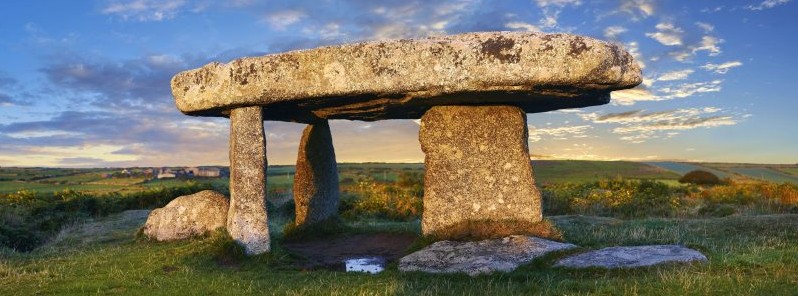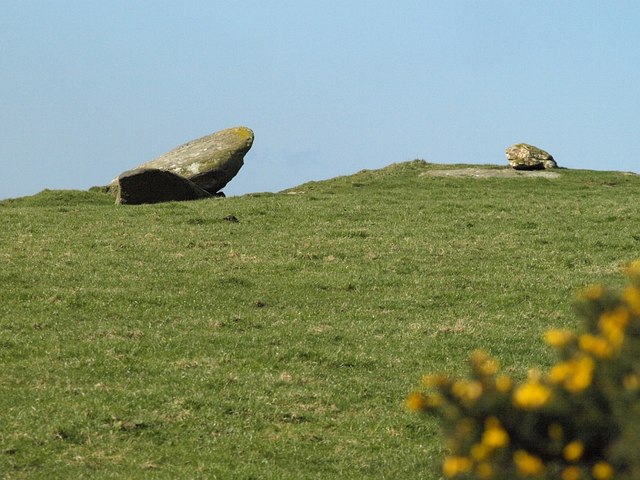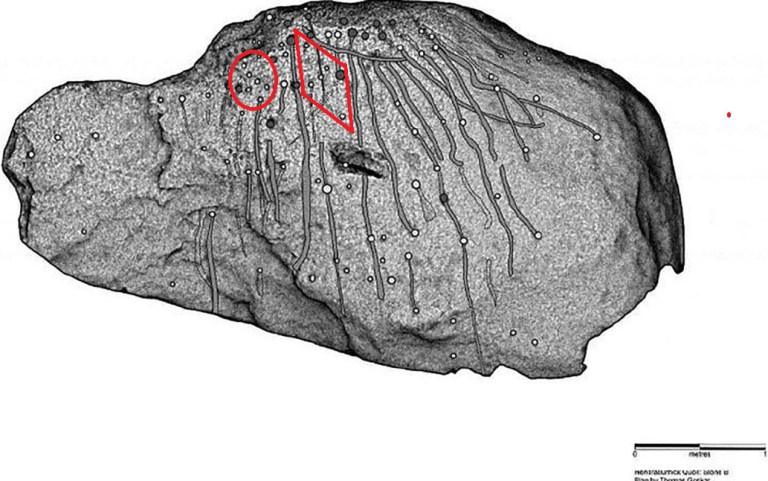England’s ancient megaliths covered in secret star marker code visible by moonlight

A recent investigation of stone-age rock art at a megalithic construction known as Hendraburnick Quoit, in Cornwall, has revealed that ten times the number of artistic markings are visible when viewed in moonlight or feeble sunlight from the south east. These mysterious markings are now exclusively revealed by Ancient News researchers to be coded star markers.
They also discovered that pieces of quartz had been deliberately crushed and spread around the site, which would have reflected moonlight, or firelight, creating an effect that would have likely accentuated any viewing of the rock-art.
Hendraburnick Quoit is a large propped ‘axe-shaped’ stone that rested upon a low platform of slates on Hendraburnick Down, near Davidstow. The investigating archaeologist, Dr. Jones, suspects that the megalithic stone was dragged up from the valley below to be used as a ritual marker associated with a more extensive Late Neolithic or Early Bronze Age, sacred site – perhaps around 2 500 BC. Dr. Jones and his team argue that the layer of slate beneath the 16-tonne quoit indicates that it was not a natural formation.
Before the research project lead by Dr. Jones and assisted by his colleague Thomas Goskar, 13 cupules (circular scoop markings) were recorded on the stone, their detailed observations under reduced light have resulted in a total of 105 engravings noted. Hendraburnick Quoit has duly been elevated to the status of the most highly decorated and complex example of rock art in southern England.
The fact that the art was created in a way that makes it more visible at night brings into question one of the prominent understandings associated with Neolithic structures, that they were features of a solar cult, often believed to be aligned with the solstice sun rise. The findings of Dr. Jones and his team would seem to suggest that some of the important megalithic sites may, in fact, be artifacts of a primarily lunar cult, with important rituals being carried out under the light of the full moon.

The fallen megalithic stone at Hendraburnick Quoit. Credit: Derek Harper
Dr. Jones, of the Cornwall Archaeological Unit, said: “I think the new marks show that this site was used at night and it is likely that other megalithic sites were as well. “Stonehenge does have markings, and I think that many more would be found at sites across the country if people were to look at them in a different light.”
Writing in the archaeology journal Time and Mind, Dr. Jones and Mr. Goskar conclude: “As in many cultures where darkness is associated with the supernatural and the heightening of senses, it is possible that some activities at Hendraburnick Quoit may have been undertaken at night.
Smashed up quartz pieces have also been discovered at the Early Bronze Age cairn at Olcote near Calanais, on the Isles of Lewis, these are already suspected to be linked with lunar rites. Similar quartz debris has been identified at a growing number of neolithic sacred spaces.
The type of markings observed is found across the ancient world and often feature an indentation surrounded by concentric circles (cup and ring marks). These cupule markings are most often found at ancient sites in Northern Europe, but similar patterns have also been found even in Australia.
Dr. Jones admits that his team has not yet deciphered the meaning of the markings, however, we can reveal that the Ancient News team’s lead researcher, Bruce R. Fenton, is first to solve the mystery.

The five brightest stars of Orion and the six brightest stars of the Pleiades are highlighted. Credit: Thomas Goskar. Annotation: Bruce R. Fenton
Fenton explains, “The cupules are in fact star markers. We see the same artistic representation of the stars, involving cupules, at sites here in Australia. As soon as I saw the image of the quoit, I looked for notable constellations among the markings and immediately found both Orion and the Pleiades.”
The research project at Hendraburnick Quoit is providing data that fits well with Fenton’s investigation into a lost global culture that emerged out from Southeast Asia during the Younger Dryas climate event. Indeed, identification of both Orion and the Pleiades on the megalith also fit well with his existing body of research material.
The discovery of the additional rock markings at the quoit was first published in the archaeology journal Time and Mind.
By Bruce R. Fenton, AncientNews.net
Featured image: Lanyon Quoit, a megalithic burial site from the Neolithic period, circa 4 000 to 3 000 BC, near Morvah on the Penwith peninsula of Cornwall. Credit: Rex Features

Commenting rules and guidelines
We value the thoughts and opinions of our readers and welcome healthy discussions on our website. In order to maintain a respectful and positive community, we ask that all commenters follow these rules.